Spa Heater Guide: Built-in, External Electric Spa Heat Pumps, Gas and Solar

With so many different spa heating options available, it’s hard to know which to choose that will work efficiently and not cost the earth to run.
Use this table for a quick comparison of the spa heating options available – we’ll talk about each one in more detail throughout this article.
Pros & Cons of spa heating options
Let’s break down the key feature differences:
| Feature | Spa Pools | Swim Spas |
| Built-In Heaters |
|
|
| Spa Heat Pumps |
|
|
| Gas |
|
|
| Solar |
|
|
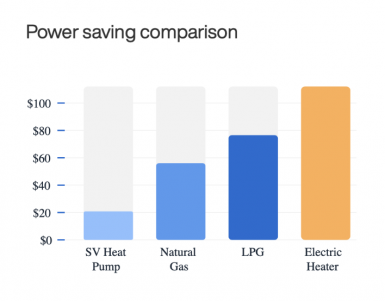
Visit your local Sapphire Spa store run through the most efficient spa heating system to suit the way you want to use your new spa. You may even be able to add an external heat and cool pump to the spa you already have to improve the energy efficiency.
Built-In Spa Heaters in the cabinet
Most spa pools on the market today already have a built-in conventional heater which is installed within the spa cabinet.
There are two types of built-in spa heaters:
- Standard spa heaters: A standard spa heater may experience load shed shutdown. This means that when you use the jet pumps, the heater will stop working to avoid overloading the system. As a result, while the jet pumps are on, your spa will gradually cool down since the heater isn't running.
- Variable spa heaters: designed to maintain your spa’s temperature efficiently while it’s in use. When you turn on the jet pump, the variable heater adjusts its power output to keep the water warm without shutting down. This means your spa can continue to heat, even when the jets are running.
Learn more about our Smart Variable Heaters
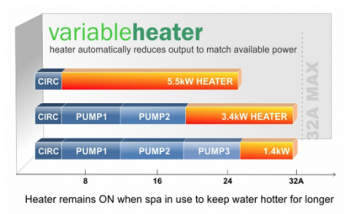
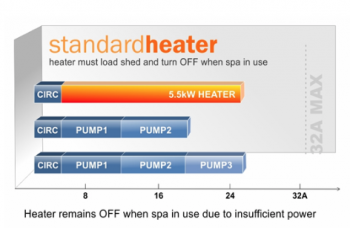
Are there any downsides to built-in spa heaters?
A typical plug-in (10 or 15 amp) spa heater may experience load shed shutdown, once you turn on the jet pumps.
Ensure the built-in heater is a variable-output spa heater; this will optimise performance to maximise heating output while the spa is in use.
When you turn on the jet pump, a variable heater will assess how much power it can use to continue to heat your spa and avoid load-shedding shut down so your spa stays warm while the jets are in use.
How long does it take to heat my spa with built-in spa heaters?
On average, built-in electric spa heaters will warm water at a degree an hour and are designed to be kept warm once your water reaches the desired temperature, to be most economical. Please ensure the hardcover is correctly fitted to prevent heat loss for the most efficient heat up.
Although your initial heat-up will take some time, keeping the spa at a ‘jump in temperature’ is the best and most economical way to utilise these heaters, instead of heating it from cold for every use.
Sapphire Spas are designed with the optimal size built-in variable spa heater within the cabinet; 3kw for spas <50 jets and 5.25kw for spas with >50 jets.
Our verdict on built-in spa heaters
The benefit of standard built-in spa heaters is that they’re fuss-free because they’re contained underneath the spa cabinet. No additional connections or installation are required, and they work well to maintain a consistent water temperature.
For most people, this is all you need to use and enjoy your spa.
But if you’re looking to reduce your running costs further, external heaters will come into play…
External Spa Heat Pump for Heating and Cooling
These air-sourced spa heat pumps are the most energy-efficient and cost-effective way to heat your spa.
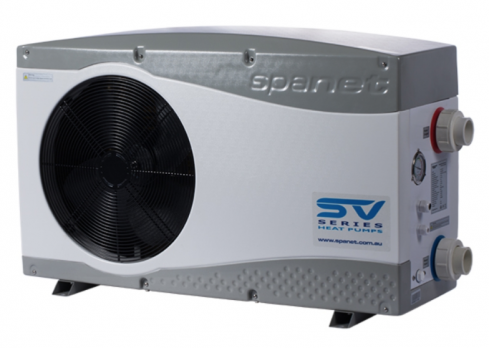
The heat pump will override your spa's built-in conventional electric element and draw up to 75% less energy.
Efficient electric spa heat pumps also use 55% less energy than natural gas.
How long does it take to heat my spa with a spa heat pump?
You can expect these external heat and cool pump spa heaters to warm the water at least twice as fast as the standard built-in electric element and they are a much more efficient way of doing it.
Can spa heat pumps cool the water, too?
Yes, another added bonus is that spa heat pumps can cool the water down, whereas all other units can only heat.
This is a great option in the summer months if you want to use your spa or swim spa as a splash pool to cool off in summer.
Think of them like the reverse cycle split system in your lounge room but for heating the water in your spa.
What’s involved with installing a spa heat pump?
As these units are external, remember that your spa heat pump will need to be installed by a spa technician. You’ll also need to find somewhere nearby to place it – the closer to the spa, the better.
We wouldn’t recommend going any further than 5 metres away to ensure that your spa heat pump works optimally.
What are the best brands of spa heat pump?
The best spa heat pump brand is Spanet.
Spanet recognised that air-sourced spa heat pumps are the most energy-efficient heating method and became the first spa controller manufacturer to develop an interface that offers true integration with a spa pool.
How does the Spanet spa heat pump work?
The power is sourced directly from the spa. A worthwhile investment, your spa heat pump will save you thousands of dollars over its lifetime.
SV Series POWERsmart spa heat pumps do not have a separate keypad for adjusting settings, rather they feature a dedicated interface to connect to any model SV Series spa controller. This allows all temperature, settings, and diagnostic adjustments to be conveniently controlled via the spa pool’s topside keypad.
Be aware that some non-integrated external spa heat pumps only allow heating but not cooling. They need to be turned on and off at the actual heater, which means you need to get out of your spa to adjust temperature settings.
The plug-and-play heat pump interface allows instant connection of an SV Series heat pump to your spa, slashing heating costs by up to 75%.
No additional power circuit or cabling is required as the SV Series heat pumps plug straight into an SV Series spa control.
The spa control automatically detects the heat pump on startup and disables the electric element of the spa control.
The installation of a spa heat pump will result in massive savings to your electricity bill, allowing you to cost-effectively keep your spa at the right temperature and ready to use all year round.
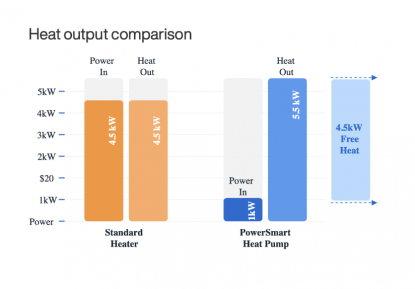
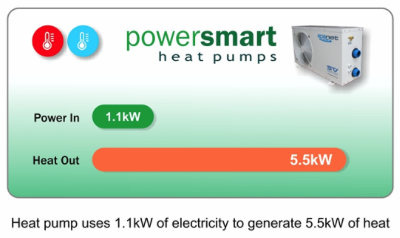
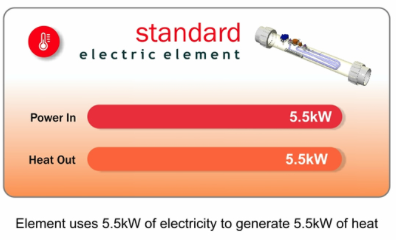
Gas Spa Heaters
The biggest draw card for gas heating systems is the speed at which they can heat water.
How long does it take to heat a spa with gas?
Let’s take a 1,000-litre spa pool, for example; when paired with a gas heating system, the spa water can be heated from cold in around an hour. Compared to an electric heater at a degree an hour, this is a big selling point.
What are the pros and cons of heating my spa with gas?
Now before you do decide on gas, keep in mind that they come in second best in terms of energy efficiency to the external heat and. cool pumps, so if running costs are your concern, then this may not be the best option for you.
Gas heating is ideal for people who will not be using their spa on a regular basis, such as people with holiday homes, who need the spa heated fast for occasional use.
These units require a little more in terms of installation, as you will need the gas line connected and a spa technician to finish the spa connections.
Solar Spa Heating
We’ve added this option in for discussion, but the truth is: solar is not a viable heating option for spas.
The average temperature that spas are used at is 37.5 degrees, and a solar system is not reliable enough to heat and maintain these high temperatures.
We want a nice, warm spa, mostly during the cooler months, when there tends to be less sun, and the opposite in the warmer months.
This can be used as a backup for your spas built in conventional heater, but due to the high set-up costs involved, most people turn to external heat and cool pumps as these are a cheaper option and much more efficient.
If you are in the market for a swim spa or spa pool anywhere in Australia, choose the option below to learn more.
Which Spa Heating System is the Best?
Our Sapphire spa pools and swim spas come standard with an adequate heating system for the volume of water you need to heat.
Typically, as the size of the spa and volume of water increase, so does the need for an increase in heater size.
These heating systems are supplied by Sapphire Spas within the price of your spa purchase:
- Spa pool / 2 hydrojet pumps / <50 jets / approx 1000 litres of water - 3kw variable output heater
- Spa pool / 3 hydrojet pumps / >50jets / approx 1300 litres of water - 5.25kw variable output heater
- Swim spa PLUNGE / 2 hydrojet pumps / approx 30 jets / approx 6000 litres of water - 3kw variable output heater
- Swim spa CLASSIC / 3 hydrojet pumps / approx 50 jets / approx 6000 litres of water - 5.25kw variable output heater
- Swim spa PREMIUM / 4 hydrojet pumps / approx 60 jets / approx 6000 litres of water - 5.5kw heat and cool pump
- Swim spa EXTREME / 5 hydrojet pumps / approx 80 jets / approx 6000 litres of water - 8.8kw heat and cool pump
- 12kw heat and cool pumps are also available for more rapid heat and cool times
You have the option to upgrade your heating system with most spa models; you’ll just need to ensure the controller that is running the system is compatible.
How can I heat my hot tub faster?
To heat your spa faster and more efficiently, consider the quality of the hardcover and the structural insulation installed around your spa pool or swim spa.
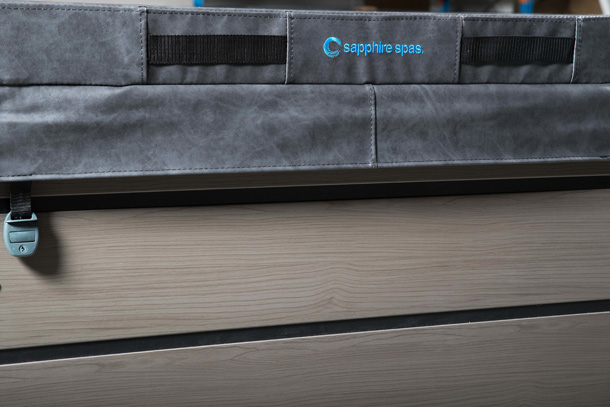
Any heating system will maintain your set water temperature best if you put your spa cover on whilst heating.
There are good and bad quality spa covers, so check the density and thickness of the foam, integrity of the vinyl (should be marine grade), ensure it has an aluminium channel to reinforce your cover under pressure, and safety locks are also important to prevent your covers lifting off in high winds.
A highly insulated spa shell is the best way to reduce heat loss and keep running costs minimal.
Our heatlock+ 4 stage insulation system allows Sapphire to create the most energy efficient spa in the world today.
Answering Your Spa Heating Questions
Is it worth getting a heat pump for a hot tub?
Yes, a heat pump saves up to 75% power cost compared to the inbuilt heater that comes with your spa and also provides cooling in warmer months. A 5.5kW heat pump is best for smaller hot tubs < 2500litres, an 8.8kW spa heat pump is suited to larger spas 2500litres+ and swim spas up to 7000litres approx. For swim spas with more jet pumps operating, a 12kW spa heat pump is the perfect money saving companion to heat 7000litres+. This powerful heating and cooling system is the cheapest way to maintain the temperature of your spa or swim spa
What is a heat pump for a spa?
A spa heat pump is basically a reverse-cycle air-conditioner (just like in your lounge room at home) but it heats and cools the water in your spa. A good heat pump will save you up to 75% on the heating cost of your spa and fully integrated systems can be controlled from the touchpad
What is the cheapest way to heat a spa?
The cheapest way to heat a spa is with an external heat pump in combination with the inbuilt heater element which comes within the spa cabinet. Make sure you buy a spa with good insulation and a hard cover which fully seals and traps the heat
How much for a new heat pump for a spa?
The smallest 5.5kW heat pump is approx $3000 / 8.8kW heat pump is approx $3500 / 12kW heat pump is approx $4000.
Click here for Spa Pools in Australia
Click here for Swim Spas in Australia